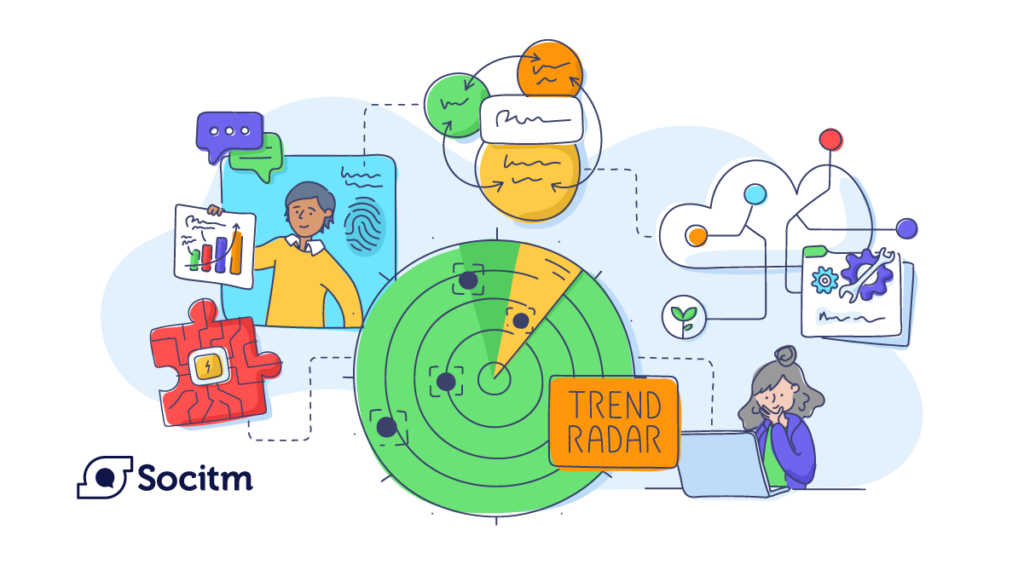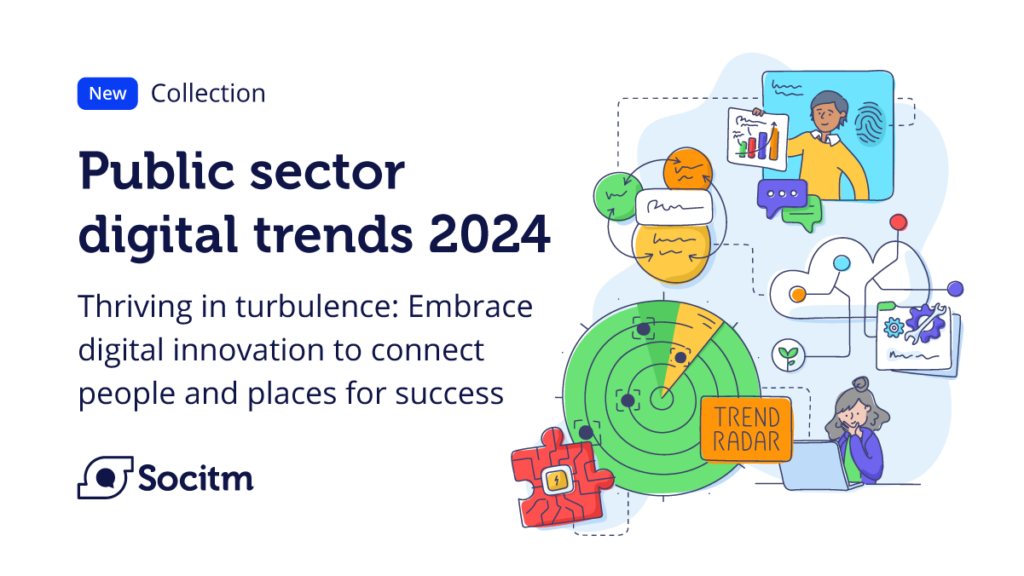PublicTechnology talks to leaders from Socitm about a report that reveals major challenges for authorities, offset by opportunities to ‘deliver digital outcomes in ways we’ve never conceived as possible’ before
“I remember when I started my career in IT,” says Jos Creese, associate director of public sector digital trade body Socitm. “The leader of my council said: ‘I don’t want to really understand anything about IT – it’s all the black arts, and I don’t need to know that, and the last thing I’m ever gonna have is a computer on my desk.’ Now, that wasn’t that long ago.”
Despite this comparative recency, a lot, clearly, has changed since then. As is evidenced by the latest edition of Socitm’s annual Public sector digital trends report, released today.
Creese tells PublicTechnology that, compared with previous years, the research that went into the new report revealed that matters of technology are “seeing much stronger political leadership – and I think that’s really important”.
The Socitm director – formerly an IT leader at Southampton City Council and Hampshire County Council, and now head of his own consultancy – said that the additional attention from elected members had initially been trained on “areas like cyber protection, because it has become one of, if not the major risks facing organisations”.
“There is a pressure on CIOs and digital leaders to be able to explain how investment in technology will deliver better digital outcomes – preferably measurable ones”
Jos Creese, Socitm
But this focus is expanding to take in other high-profile areas of risk and opportunity – such as artificial intelligence – which, concomitantly, are increasingly important to citizens.
“Politicians want to be in control of the things that matter to the public,” he says. “And this is now something that matters much more than it ever did to the public – particularly in a post-covid world: they care about whether they can get stuff online, much more than simply saying: ‘Well, I ought to be able to do this online’. It is becoming much more of a political issue if your council is failing, in comparison to others, in that respect.”
The Socitm report picks out 10 key trends – five from the field of digital services, and five related to technology tools and infrastructure – that will help define the parameters of success and failure for public services over the coming 12 months. Respectively, the two sets of issues picked out by the research are:
- technology for public good
- reimagining services
- community resilience
- local and national leadership
- skills and capacity
- AI applications
- harnessing data
- cyber protection
- spatial technologies
- infrastructure and cloud
Public bodies’ burgeoning interest in how technology can contribute to public good is, in part, a reaction to the growing awareness of its potential for harm – such as through its environmental impact, and the risks to privacy and security presented by AI and data sharing.
Martin Ferguson, director of policy and research at Socitm, again cites the impact of the pandemic on highlighting and prioritising issues.
“Covid has really brought to the fore the vulnerabilities of different groups within our society – the need for access to green space, and a whole variety of wellbeing issues that previously, perhaps, were not so dominant in the public eye,” he says,
“There are opportunities now, particularly using data more effectively, and in more joined-up ways: in Leeds, they’re using something called the Social Progress Index to look at the performance of local economies, and help work out best ways of supporting those economies. In Lichfield, their net zero strategy, just has simple analysis of utility bills – but doing it using technology that makes it quick and easy to do. In Hampshire, work has been going on looking at extra care provision, and has come up with the conclusion that doubling existing provision over the next couple of years will, in 10 years’ time, have a major impact in terms of the reduction in costs, where people would otherwise have ended up in hospital or in other types of social care support. So, there are lots of examples where IT and using data and technology together for public good are starting to come to the fore.”
Active imagination
The trend of ‘reimagined’ public services set out in the Socitm study speaks to an environment where transformation is no longer measured by simple channel shift from manual to digital delivery.
“Even where services are face-to-face, such as in a hospital, they are increasingly underpinned by a mesh of digitised service components, from booking systems to tracking, diagnostics, connected and automated micro services, and sophisticated data analytics,” the report says.
The concept of ‘community resilience’ is similarly representative of a world in which digital is no longer an adjunct, but present throughout the foundations and architecture of society itself.
The report says: “[This year] will see a significant change in this agenda for public services, with a focus on the contribution of digital and IT to the mitigation of a community-wide risks, as public services operate in a connected system of inter-dependent services, communities, geographies, and infrastructures.”
It is little surprise to see the issue of ‘skills and capacity’ among this year’s defining trends. And, according to Ferguson, local public services continue to face well-worn challenges in accessing expertise, with areas of particular need including cybersecurity, data analytics, and the management of complex IT infrastructure.
“But I think there are positive signs,” he adds. “I think local government is waking up to the opportunities, for example, of apprenticeships, and being able to bring people on board with new and different skills to fill these gaps… there’s a growing body of experience that is showing that the new generation of people coming into these kinds of opportunities are wanting something rather more from their jobs, in terms of offering something back into society and into communities. And that’s what local government, in its most positive form, is really about… So we’re finding that young people are, not only are taking advantage of these opportunities, but then are sticking with them, rather than running off to high salaries in the private sector.”
The areas where local councils most require additional skills align closely with the major technology trends cited in the report, including the harnessing of data – which goes hand in hand with the year’s two most prevalent letters: AI.
Creese tells PublicTechnology that a number of authorities are already moving beyond simple consideration of the impact of artificial intelligence and automation, and are putting the technology into action in several areas.
“You’re finding AI capability embedded… in specialist applications that are doing automated data-interrogations matching trigger alerts and so on,” he says. “It is also being used, and will, we think, increasingly be used in specific areas – health diagnostics is the one that we always see, where there is the ability for AI to be able to interpret scans and data and make linkages to see patterns. The same will apply to policing and in areas such as environmental management… you can begin to do better predictive analytics through some of these AI tools. It’s also beginning to be used in an area that we think is going to be increasingly important – in some of the administrative decision-making practices in public bodies.”
The Socitm director adds: “The way it’s worked in the past is you have large numbers of reports and working groups and committees and teams and structures, and you all consider stuff and you go away and produce more information, then you analyse it, and then you make recommendations to the politicians. And, finally, a decision is taken. A lot of that can be speeded up by AI; how can we analyse the data and produce a coherent report for politicians to scrutinise or executive leaders to consider, before the level of human intervention that is the final decision? It’s not about end-to-end automation. But we’re talking about being able to corral and collect the data in much better ways to support decision-making processes.”
One area of emerging technology featured in the report – and whose inclusion might come as more of a surprise than AI – is ‘spatial technologies’. The study defines the area as including: digital twins powered by virtual and augmented reality; data analysis of connected places; virtual services in virtual places; tracking and connecting resources.
Outcomes and possibilities
Whatever new technologies and digital developments are implemented by councils, it is imperative that their infrastructure can support it. The extent to which organisations make use of cloud or on-premises is no longer the key question, however. The focus, rather, is on what the end result is for services and the citizens that use them.
The new generation of people coming into these kinds of opportunities are wanting something rather more from their jobs, in terms of offering something back into society and into communities.
Martin Ferguson, Socitm
“With the growth in the pace of a move to a digital operating model, infrastructure is under some pressure,” Creese says. “We’ve picked up quite a few public bodies that are saying ‘we need to invest in technology infrastructure – our assets, our servers and networks and configuration is insufficient for the job.; it’s becoming vulnerable, and is now a weak link in the chain’… public service organisations understand that but IT managers can’t simply say: ‘I want a load more servers’ anymore.”
He adds: “[Organisations] want to understand what the digital value of this is going to be. So, there is a pressure on CIOs and digital leaders to be able to explain how investment in technology will deliver better digital outcomes – preferably measurable ones. That is not easy. And there’s an issue for suppliers in doing that as well.”
Pressure is nothing new for the local government and health sectors and, for many leaders and organisations, it will continue to intensify. But, as the Socitm report demonstrates, it will often also be accompanied by an equally powerful scope for innovation.
“We see 2024 as a bit of a turning point; we’ve come through an interesting and difficult period, and we’ve got some new and exciting technologies,” Creese says.
“The opportunity is enormous. The pressures are enormous. And we see this as the start of the next decade of very significant change in how public services use technologies to deliver digital outcomes for the public in ways that I don’t think we’ve even conceived as being possible in the past.”

The Socitm Public sector digital trends 2024 can be read in full here






